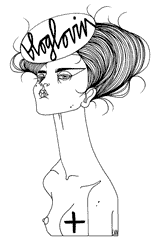I have been living in Holland for five years and three months now—man, that seems like a long time—and yet I'm still discovering its treasures. Holland is such a small country and sometimes you feel like you've seen it all but, no, there's always more. There are hidden gems everywhere you travel. You just need to dig a little deeper, search for them.
This summer, we have been busier than ever before, traveling around the country and seeing (almost) all that is has to offer. We still have places to visit, people to meet, there are plenty of good times to be had. Of that I'm certain.
We traveled north, to Volendam, an old Dutch fishing village. Small traditional houses, drawbridges, traditional costumes and wooden clogs, a harbor filled with old fishing boats and well, fish; that's what Volendam is famous for.
We ate a lot of raw Dutch herring there. And yes, we liked it.
Haring met broodje en ui (herring with bread and onion or pickles) and on the far left, smoked eel. Not the most romantic food, no?
And of course, we had our sweet treat, poffertjes, little Dutch pancakes, dusted with lots of icing sugar. They're delicious. Who needs regular pancakes when you can have these?
We traveled southwest to the province of Zeeland, Zealand in English, and if that name makes you think of New Zealand, you're correct. The island country of New Zealand is named after the Dutch province of Zeeland after it was discovered by a Dutch seafarer.
Zeeland is famous for its tiny brown shrimp and its pastry. Oh, the pastry, I loved it all.
We first visited the capital of Zeeland, Middelburg, which during the Middle Ages was an important trading center and one of the most powerful cities of the Low Countries.
The Middelburg Stadhuis (City Hall), built in late-gothic style during the Middle Ages. It is now a University.
Then we went to the picturesque village of Burgh-Haamstede.
We went to the most amazing bakery, run by a Jewish baker, with recipes for bread and pastries almost as old as the village itself. The owner, Harry Sonnemans, collects Volkswagen cars and motorcycles and his bakery, as well as the surrounding area, is filled with crazy VW knick-knacks.
Okay, this is the stuff dreams are made of. Soft and amazingly fluffy like the best doughnut you'll ever have, with a cinnamon-y, nutmeg-y, dark brown sugary, sweet glaze. And did I tell you it's baked? Yep, no greasy oils here. This is the Zeeuwse bolus, a traditional pastry of Zeeland, of Jewish origin.
This is the Zeeuwse kruidkoek, meaning spice cookie, and it's a spicy cake-biscuit. It's sticky and gooey and soft and has chocolate and marzipan and nuts inside. Crazy good.
Take a speculaas biscuit and remove that pungent spicy flavor, leaving only the cinnamon and brown sugar. Coat it with caster sugar and you're set. Perfection. That's the Zeeuwse speculaas, milder than the traditional speculaas and much more to my taste.
In the upcoming months, I plan on sharing with you recipes for all the aforementioned sweet treats. Hold on tight!!
This summer, we have been busier than ever before, traveling around the country and seeing (almost) all that is has to offer. We still have places to visit, people to meet, there are plenty of good times to be had. Of that I'm certain.
We traveled north, to Volendam, an old Dutch fishing village. Small traditional houses, drawbridges, traditional costumes and wooden clogs, a harbor filled with old fishing boats and well, fish; that's what Volendam is famous for.
We ate a lot of raw Dutch herring there. And yes, we liked it.
Haring met broodje en ui (herring with bread and onion or pickles) and on the far left, smoked eel. Not the most romantic food, no?
And of course, we had our sweet treat, poffertjes, little Dutch pancakes, dusted with lots of icing sugar. They're delicious. Who needs regular pancakes when you can have these?
We traveled southwest to the province of Zeeland, Zealand in English, and if that name makes you think of New Zealand, you're correct. The island country of New Zealand is named after the Dutch province of Zeeland after it was discovered by a Dutch seafarer.
Zeeland is famous for its tiny brown shrimp and its pastry. Oh, the pastry, I loved it all.
We first visited the capital of Zeeland, Middelburg, which during the Middle Ages was an important trading center and one of the most powerful cities of the Low Countries.
The Middelburg Stadhuis (City Hall), built in late-gothic style during the Middle Ages. It is now a University.
Then we went to the picturesque village of Burgh-Haamstede.
We went to the most amazing bakery, run by a Jewish baker, with recipes for bread and pastries almost as old as the village itself. The owner, Harry Sonnemans, collects Volkswagen cars and motorcycles and his bakery, as well as the surrounding area, is filled with crazy VW knick-knacks.
Okay, this is the stuff dreams are made of. Soft and amazingly fluffy like the best doughnut you'll ever have, with a cinnamon-y, nutmeg-y, dark brown sugary, sweet glaze. And did I tell you it's baked? Yep, no greasy oils here. This is the Zeeuwse bolus, a traditional pastry of Zeeland, of Jewish origin.
This is the Zeeuwse kruidkoek, meaning spice cookie, and it's a spicy cake-biscuit. It's sticky and gooey and soft and has chocolate and marzipan and nuts inside. Crazy good.
Take a speculaas biscuit and remove that pungent spicy flavor, leaving only the cinnamon and brown sugar. Coat it with caster sugar and you're set. Perfection. That's the Zeeuwse speculaas, milder than the traditional speculaas and much more to my taste.
In the upcoming months, I plan on sharing with you recipes for all the aforementioned sweet treats. Hold on tight!!











































































